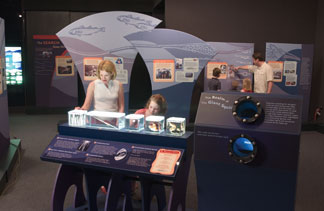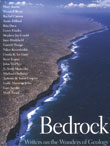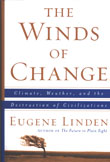|
Geomedia
Geotimes.org offers each month's book reviews, list of new books, book ordering information and new maps.
Check out this month's On the Web links, your connection to earth science friendly Web sites. The popular Geomedia feature is now available by topic.
On Exhibit: The traveling
Smithsonian
Books: Sharing Earth’s beauty: A review
of Bedrock: Writers on the Wonders of Geology
Books: Societal shifts: A review of The Winds
of Change: Climate, Weather, and the Destruction of Civilizations
The traveling Smithsonian
 Walking
into the National Museum of Natural History in Washington, D.C., in the
dead of summer can be intimidating: Hundreds of children scamper about,
clamoring over the Hope Diamond in the museum’s gems and minerals
section or the giant mammoth in the Ice Age exhibit on mammals. Visitors
can escape some of that mayhem, however, by wandering into a less-visited,
though compelling, special exhibit entitled Wondrous Cold: An Antarctic
Journey — one of many traveling exhibits that could come to a town
near you at some point in the future.
Walking
into the National Museum of Natural History in Washington, D.C., in the
dead of summer can be intimidating: Hundreds of children scamper about,
clamoring over the Hope Diamond in the museum’s gems and minerals
section or the giant mammoth in the Ice Age exhibit on mammals. Visitors
can escape some of that mayhem, however, by wandering into a less-visited,
though compelling, special exhibit entitled Wondrous Cold: An Antarctic
Journey — one of many traveling exhibits that could come to a town
near you at some point in the future.
The Smithsonian Institution’s Traveling Exhibition Services program develops exhibits such as Giant Squid, shown here, that travel to museums and other venues around the country, offering visitors a little piece of the Smithsonian in their own backyards.Photograph is courtesy of SITES.
If you’re lucky enough to be in the nation’s capital while Wondrous Cold is still at the National Museum of Natural History (until Sept. 4), it’s well worth the 45 minutes it takes to wander through. But even if you are not planning on a trip to Washington, you may be able to catch it as it travels around the country on a 15-venue tour through 2010. A part of the Smithsonian Institution’s Traveling Exhibition Service (SITES), the Wondrous Cold exhibit is based on a book of the same title by photographer Joan Myers, who spent October 2002 through January 2003 in Antarctica as part of the National Science Foundation’s Antarctic Artists and Writers program (see Geotimes, March 2006).
Wondrous Cold encompasses a series of 50 stunning color and black-and-white photographs, showing everything from an ice-core sample of million-year-old ice and scientists working at the southern continent’s McMurdo Station, to huge penguin colonies at Gold Harbor and Ernest Shackleton’s hut from his early 20th century expedition. Alongside many of the photographs are textboxes explaining the photos, as well as some of Myers’ journal entries while in Antarctica. Visitors learn that Myers explored the continent via plane, ship, helicopter and snowmobile, and that everyone’s favorite days on the cold continent are the days in which the “freshies” — fresh fruit and vegetables — are delivered.
As this exhibit is composed primarily of framed photographs and text, it’s one that is pretty easy to send elsewhere, says Jennifer Schommer, a spokesperson for the SITES program. Immediately following its stay in Washington, the exhibit will head to Miami, Fla., and then to Jackson, Wyo.
At any given time, SITES has between 50 and 60 exhibits on display at various local museums, science centers, public libraries, historical centers, aquariums, train stations, botanical gardens, public shopping malls and schools, Schommer says. Since the program began in 1952, Smithsonian has developed and sent out more than 1,500 exhibitions to 250 different communities in almost every state. “Our mission is to get the Smithsonian to people who can’t get to D.C.,” she says.
Most traveling exhibits are based on the Smithsonian’s collections and expertise, Schommer says. They cover art, science, history and pop culture through photos, interpretive materials and artifacts. Exhibits have included everything from collections of dresses of the First Ladies and classic lunchboxes, to the scientific explorations of the Burgess Shale and Mars.
Venues that want to book one of the SITES exhibits need merely contact the program. Along with the actual exhibit, SITES sends logistical help, such as how to put the exhibit together and what kind of security requirement there is, as well as educational resources and public relations support, says Devra Wexler, a project manager at SITES.
Most of the exhibits are developed by the scientists and project directors at SITES over a period of eight months to two years. Wexler, for example, is working on a new exhibit that will open in November called “Earth From Space.” For the last two years, she and her colleagues at SITES have been working with Andrew Johnston, a curator at the National Air and Space Museum, on building the exhibit based on Johnston’s book by the same name. The exhibit will be based on remote sensing and satellite images of features on Earth, and will have geologic explanations alongside the images in the final product.
Johnston and the SITES team worked together to choose the images. Johnston wrote the “script,” or the explanations, which Wexler, a geologist, and a team of editors reviewed. “We have a series of checks and balances to ensure that everything is correct and makes sense,” Wexler says. When the team does not have a resident expert on the topic, they turn to the expertise of the Smithsonian curators and researchers to ensure that all of the exhibits are accurate.
Like many exhibits, Earth From Space will have an accompanying Web site, which will go live in October, Wexler says. Education and outreach is very important to SITES’ mission, she says, so putting up Web sites and sending educational materials along with the exhibits is par for the course.
Of course, Wexler says, none of this comes cheaply. Partially funded by Congress, Smithsonian supplements the costs of the exhibits by charging a nominal fee — from $2,500 to $10,000 per exhibit, for an 8- to 12-week showing — to the venues that take on the exhibit, and also by seeking donations or sponsorship. Earth From Space, for example, is co-sponsored by the U.S. Geological Survey and the Smithsonian Women’s Committee. Wondrous Cold is sponsored by Quark Expeditions, a company that leads expeditions to Antarctica. “It’s a nice partnership,” Wexler says.
These partnerships “allow you to get the Smithsonian in your own backyard,” Schommer says. Whether your backyard is Washington, D.C., and you can stop by the Museum of Natural History this month to visit Wondrous Cold, or you’re in Bryan, Texas, and want to see the Burgess Shale exhibit, she says, remember that traveling exhibits are “always something new.”
Megan Sever
Links:
"Antarctica Through the
Eyes of Writers and Artists," Geotimes, March 2006
Smithsonian
Institution's Traveling Exhibition Service
Book review
 Bedrock:
Writers on the Wonders of Geology Bedrock:
Writers on the Wonders of Geologyedited by Lauret E. Savoy, Eldridge M. Moores, and Judith E. Moores. Trinity University Press, 2006. ISBN 1 5953 4023 8. Paperback, $24.95; Hardback, $45.00. |
David Williams
“I hear…again and again from readers who complain about geologic descriptions in text: geology is too difficult, too complicated, too hard to understand,” writes Ann Zwinger. Although she has sympathy for her readers, Zwinger laments this all-too-common response. For Zwinger, a landscape does not come to life until she knows its story — the how, what, where and when of a place. “It makes my day,” she concludes, to tune into a “world so long ago and different from my own.”
Zwinger describes this experience in the essay “A Question of Conglomerate,” which appears in a new compilation of geologic writings, Bedrock: Writers on the Wonders of Geology. Her story could serve as a leitmotif for the book. Edited by geologists Lauret Savoy and Eldridge Moores, and his wife Judith Moores, Bedrock brings together nearly 2,000 years of stories about the planet. The works of poetry, fiction and nonfiction range across cultures and include authors as diverse as James Joyce, Langston Hughes and Antoine de Saint-Exupéry, as well as scientists such as James Hutton, Stephen Jay Gould and Grove Karl Gilbert.
Organized by theme, each section includes an introductory essay by the editors. The essays are critical to the book as they give some necessary scientific background for nongeologists in addition to putting the writers in context. Themes include deep time, earthquakes, wind and desert, and the work of ice. They fit into the editors’ overall goal of helping us to “better sense and live the larger ‘geologic experience’ encompassing all our lives.”
To many, geology is more than just rocks; it anchors their lives. For Luci Tapahonso, her homeland — the Navajo country of the American Southwest — is a sacred landscape filled with stories that tie her more deeply to her community. Ivan Doig writes of landscape as a central character in his beautiful story of growing up in Montana. The mountains offer enticement, a new country for pioneers and a promise of riches. But landscape can also be treacherous, as John Steinbeck describes in a selection from The Grapes of Wrath. For each of these writers, Earth is alive.
Although most of the selections are not written by professional geologists, the ones that are crackle with passion. French volcanologist and filmmaker Haroun Tazeiff tells a nerve-wracking tale of walking in an active crater, while August Gansser, a Swiss geologist and alpinist, details an equally harrowing trek across the Himalayas in 1936.
It is also good to be reminded of some of the classic geologist lines. In his report on the San Francisco earthquake of 1906, Grove Karl Gilbert wrote: “It is the natural and legitimate ambition of a properly constituted geologist to see a glacier, witness an eruption and feel an earthquake…[therefore] it was with unalloyed pleasure that I became aware that a vigorous earthquake was in progress.” John Wesley Powell, Gilbert’s one-time boss at the U.S. Geological Survey, wrote of the first ever descent of the Grand Canyon: “We have an unknown distance yet to run, an unknown river to explore. What falls there are, we know not; what rocks beset the channel, we know not; what walls rise over the river, we know not. Ah, well!”
Bedrock is not a book from which to learn geology — there are errors in some descriptions — but a book to appreciate the richness of geology and how it affects us. It reveals the excitement of being a geologist. It shows that there are many ways to see and interpret the world. In the words of David Levenson, “With the geologist lies the special responsibility and opportunity of revealing the earth in all its beauty and power.” Bedrock is a good place to get inspiration to do just that.
Williams is a Geotimes contributing writer, based in Seattle, Wash., and author of The Street-Smart Naturalist.
Book review
 The
Winds of Change: Climate, Weather, and the Destruction of Civilizations The
Winds of Change: Climate, Weather, and the Destruction of Civilizationsby Eugene Linden. Simon and Schuster, 2006. ISBN 0 684 86352 9. Hardcover, $26.00. |
Richardson B. Gill
In The Winds of Change, Eugene Linden investigates the effects of past climate on human society. He has gathered evidence of the devastation that can occur when climate suddenly shifts, and the environment for which a culture had adapted itself is suddenly changed.
Linden presents his evidence in the format of a trial, complete with charges, examination of evidence and closing arguments. In this particular trial, he charges that climate changes have destroyed or seriously affected civilizations in the past. He presents evidence that cultures have succumbed to those climate changes, and he argues that future climatic change due to human induced global warming will have potentially catastrophic effects on modern civilization.
To better understand the importance of his book, it is important to understand the theoretical background on which it is written. When anthropologists and archaeologists first began to study the interrelation between climate and culture, both sciences were in a very rudimentary stage of development. Even though those early investigators did the best they could with the information available, the chronologies proposed by the archaeologists, who didn’t have the benefit of modern dating techniques, were often off by hundreds of years. Likewise, the understanding of climate — how it worked and its past history — was often inexact or mistaken.
Early researchers, therefore, tried to line up misunderstandings of climate with inaccurate chronologies and draw conclusions about the role of climate in past cultures. But as the understanding of both disciplines improved, it became clear that the early efforts were widely off the mark.
Such attempts to correlate climate and culture fell into disrepute and were derided as “environmental determinism.” Over the bulk of the last 30 years, most anthropologists and archaeologists have dismissed the role of climate in human society. Climate for the last 10,000 years was seen as very stable, with cultures being able to adjust and adapt to any changes that might have occurred.
Against this background, Linden has chosen to look at the evidence that has developed in recent years that shows that climate has indeed played a major role in the history of past cultures. He starts with the role that climate may have played in the development of humans by presenting the evidence for climatic change as a driving factor in the evolution of Homo in general and Homo sapiens in particular (see Geotimes, September 2005). He then moves to examine climatic disasters during the last 10,000 years, the Holocene.
From the Younger Dryas abrupt cooling event about 8,200 years ago, which plunged temperatures in Europe, to the Little Ice Age from the mid-14th to mid-19th centuries, during which ice fairs were held on the frozen Thames in London, he moves through different climatic evidence that could support widespread changes in civilization. One particularly interesting disaster he discusses was in A.D. 536, when the sky around the world suddenly lost its blue color and turned milky white for 18 months. The cause was a dry fog that enveloped the upper atmosphere and was reported in historical documents from the Mediterranean to China. The sun only shone four hours a day in the summer — a person standing in the sun would not cast a shadow, temperatures plunged, summer frosts were reported from the Italian peninsula to the Middle East, crops failed to ripen, and famine developed. It was a time of starvation and death in many places of the world.
Looking at climatic events that affected the Middle East, Mexico, Central America, Linden marshals a large, well-researched body of evidence in support of the idea that climate has in the past had disastrous effects on people. (In the interest of full disclosure, it should be noted that this reviewer’s work is respectfully quoted several times in the book as it relates to the collapse of the Maya civilization and droughts.) In his closing argument, Linden argues that having demonstrated that climate has destroyed cultures in the past, we should be worried about what climate can do in the future.
Linden concludes: “Even as human activities have increased the likelihood of extreme weather events, they have decreased nature’s ability to contain the damage.” He presents an articulate plea for the world to stop emitting carbon dioxide into the atmosphere, which he argues is the primary cause of the recent global warming.
His closing argument, however, ignores the body of evidence presented by those who do not agree that the recent global warming is entirely the result of human activities. As in many issues of scientific debate, serious scientists exist on both sides who have presented evidence in support of their ideas.
Despite Linden’s focus only on the one side of the argument, however, The Winds of Change is a very well-written book, as one might expect from a science writer who has written seven books and many articles for a distinguished list of newspapers, magazines and journals. But even more importantly, it contains an impressive body of research, one that will serve as a good primer to anyone interested in the link between climate and society.
Gill is an independent scholar in San Antonio, Texas, who studies the relationship between climate and the collapse of Classic Maya civilization, and he is recent author of The Great Maya Droughts: Water, Life & Death.
Links:
"A
Changing Climate for Human Evolution," Geotimes, September
2005

 Subscribe
Subscribe

